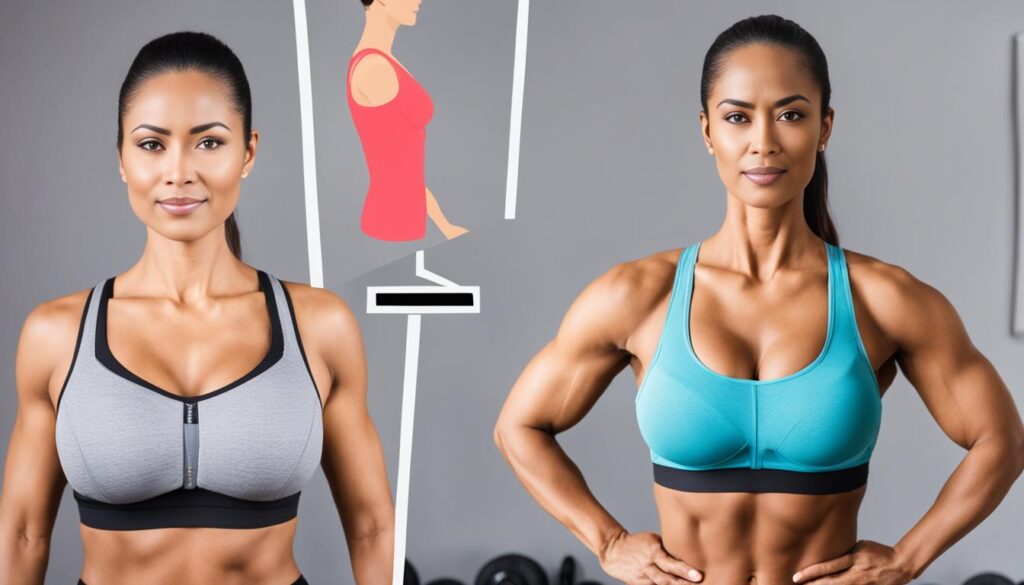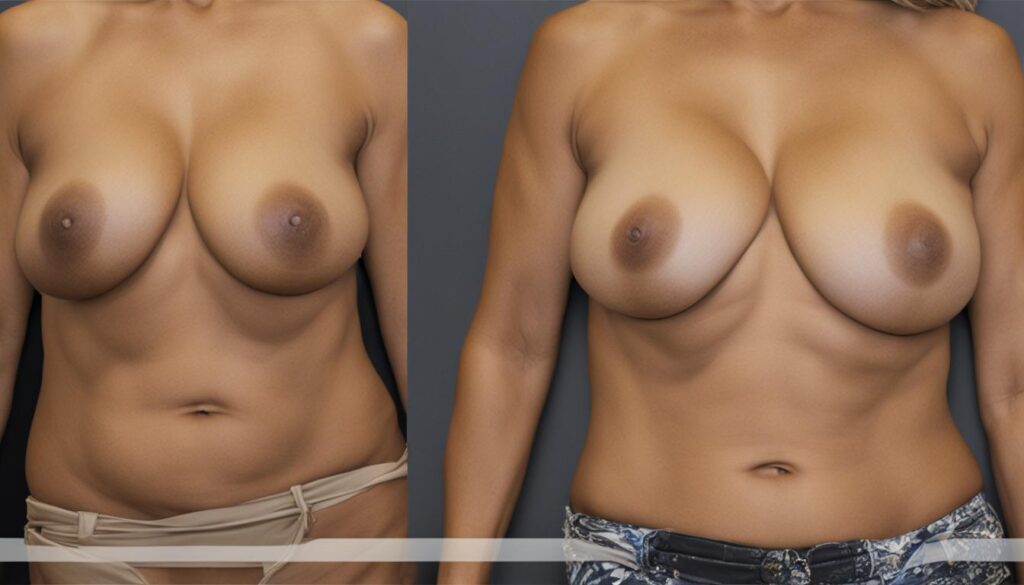The information provided in this article is intended for educational purposes only and should not be construed as medical advice. Although the author is a medical professional, the information presented here does not establish a doctor-patient relationship. Always consult with a qualified healthcare provider before making any decisions about your health or treatment.
As women age, it is natural for the breasts to lose elasticity and sag. While it is not possible to fully restore the original shape of the breasts, there are several effective solutions that can help minimize sagging and improve firmness. This article will explore the causes of sagging breasts, natural remedies such as exercise and nutrition, the importance of posture and bra support, the impact of smoking and sun exposure on breast elasticity, weight management to prevent further sagging, non-surgical and surgical options for breast lift, tips for preventing future sagging, and embracing natural changes with confidence. Testimonials and success stories of non-surgical breast lifts will also be shared. By implementing these solutions, women can address sagging breasts and enhance their overall breast appearance without undergoing surgery.
Contents
- 1 Understanding Breast Ptosis and its Natural Progression
- 2 Identifying the Causes of Sagging Breasts
- 3 How to Fix Sagging Breast through Exercise
- 4 Nutrition’s Role in Minimizing Breast Sagging
- 5 Posture and Breast Support Strategies
- 6 Bra Fitting and Selection: Maximizing Support for Your Breasts
- 7 The Impact of Smoking and Sun Exposure on Breast Elasticity
- 8 Weight Management to Prevent Further Breast Sagging
- 9 The Pros and Cons of Non-Surgical Breast Lift Options
- 10 Understanding Surgical Solutions: Breast Lifts and Augmentation
- 11 Comparing Non-Surgical and Surgical Approaches
- 12 Preventing Future Sagging: Tips and Lifestyle Adjustments
- 13 Realistic Expectations: Embracing Natural Changes with Confidence
- 14 Testimonials and Success Stories of Non-Surgical Breast Lifts
- 15 Conclusion
- 16 Source Links
Key Takeaways:
- Understanding the natural progression of breast ptosis (sagging) is crucial in finding effective solutions.
- Genetics, lifestyle, and environmental factors can contribute to sagging breasts.
- Exercise and nutrition play important roles in minimizing breast sagging.
- Maintaining good posture and wearing supportive bras can help prevent and minimize sagging.
- Non-surgical and surgical options are available to address sagging breasts, depending on individual preferences and goals.
As you continue reading, you will discover actionable strategies and insights to help you effectively address sagging breasts, empowering you to make informed decisions about your breast health and appearance.
Understanding Breast Ptosis and its Natural Progression
Breast ptosis, commonly known as sagging breasts, is a natural condition that occurs as women age. It is characterized by the breasts losing their elasticity and drooping. Breast ptosis can vary in severity, ranging from mild to severe sagging. Over time, the shape of the breasts may change, with the nipple pointing downwards and the top of the breasts appearing less full. This natural progression can be influenced by factors such as genetics, weight fluctuations, pregnancy, breastfeeding, and hormonal changes. Understanding breast ptosis and its natural progression is essential in finding effective solutions to minimize sagging and improve breast appearance.
What is Breast Ptosis?
Breast ptosis, also known as breast sagging, refers to the downward displacement of the breasts due to the loss of elasticity and support in the breast tissue and skin. The degree of sagging can vary depending on factors such as age, genetics, lifestyle, and hormonal changes. The severity of breast ptosis can be classified into different grades, ranging from mild sagging (Grade 1) to severe drooping (Grade 3). It is important to note that breast ptosis is a natural part of the aging process and can occur in women of all breast sizes.
Common Changes in Breast Shape Over Time
As breasts experience ptosis, the overall shape and appearance can undergo noticeable changes. Some common changes include:
- Loss of fullness in the upper part of the breasts
- Nipples pointing downward
- Increased distance between the nipples and the inframammary fold (the crease beneath the breasts)
- Stretching and elongation of the breast tissue
- Loss of volume and firmness
These changes can affect the overall contour and symmetry of the breasts, leading to feelings of self-consciousness and dissatisfaction with breast appearance.
Identifying the Causes of Sagging Breasts
There are several factors that contribute to sagging breasts. Understanding these causes can help women make informed choices to prevent sagging and address breast sagging effectively.
Genetics and Breast Tissue Composition
Genetics play a role in determining the composition of breast tissue, including its firmness and elasticity. Some individuals may be genetically predisposed to have breasts with less supportive connective tissue, making them more prone to sagging.
Impact of Lifestyle and Environmental Factors
Lifestyle and environmental factors can also influence breast sagging. Certain habits and behaviors can have a negative impact on the skin’s elasticity and contribute to sagging breasts. Factors such as smoking, excessive sun exposure, significant weight fluctuations, pregnancy, breastfeeding, and certain illnesses can all affect breast support and tissue resilience.
To prevent saggy breasts and maintain breast health, it is important to adopt a healthy lifestyle and minimize exposure to harmful elements. Quitting smoking, protecting the skin from the sun’s harmful UV rays, maintaining a stable weight, and taking care of overall health can help reduce the risk of sagging breasts.
By being aware of the causes of sagging breasts and making lifestyle adjustments, women can take proactive steps to prevent sagging and maintain the appearance and firmness of their breasts.
How to Fix Sagging Breast through Exercise
Exercise is a natural and effective way to improve the appearance of sagging breasts. While exercise cannot directly firm breast tissue, it can strengthen the chest muscles, improve posture, and provide lift to the breasts. By incorporating specific chest exercises into your routine, you can target the muscles beneath the breasts and enhance the overall appearance of your chest.
Types of Chest Exercises to Consider
When it comes to fixing sagging breasts through exercise, there are several types of chest exercises that you can consider:
- Push-ups: This classic exercise targets the muscles in your chest, shoulders, and arms while also engaging your core. Modify the exercise based on your fitness level, starting with wall push-ups and gradually progressing to traditional push-ups.
- Swimming: Swimming is a great full-body workout that engages the muscles in your chest, arms, and shoulders. The resistance of the water helps to tone and strengthen these muscles, giving your breasts a subtle lift.
- Bench Press: Using a barbell or dumbbells, the bench press exercise primarily targets the pectoral muscles. Start with lighter weights and gradually increase the resistance as you build strength and confidence.
- Arm Curls: Arm curls not only tone your biceps but also engage your chest muscles. Hold a pair of dumbbells with your palms facing forward and slowly curl your arms up towards your shoulders. Focus on controlled movements to maximize the benefits of this exercise.
By incorporating these chest exercises into your workout routine, you can effectively target the muscles that support your breasts and potentially reduce the appearance of sagging.
Building a Sustainable Exercise Routine
To achieve lasting results and maintain the firmness of your breasts, it’s important to build a sustainable exercise routine. Here are some tips to consider:
- Start slowly and gradually increase the intensity and frequency of your workouts to avoid overexertion and injury.
- Include a variety of exercises that target different muscle groups in your chest and upper body.
- Set realistic goals and track your progress to stay motivated and focused on your exercise routine.
- Listen to your body and give yourself time to rest and recover between workouts.
- Stay consistent with your exercise routine to maintain the benefits over time.
Remember, exercise alone may not completely fix sagging breasts, as the appearance of your breasts is influenced by various factors. However, building a sustainable exercise routine that includes chest exercises can contribute to reducing breast sagging and improving overall breast firmness.
Nutrition’s Role in Minimizing Breast Sagging
Proper nutrition and a balanced diet are essential factors in maintaining skin health and minimizing breast sagging. By consuming a varied and nutrient-rich diet, including fruits, vegetables, lean proteins, and whole grains, women can nourish their skin and promote elasticity and strength.
Essential nutrients such as vitamins, minerals, and antioxidants found in these foods play a vital role in supporting skin health and maintaining the firmness of breast tissue. Antioxidants, in particular, help protect the skin from damage caused by free radicals, minimizing the signs of aging and sagging over time.
Importance of a Balanced Diet for Skin Health
A balanced diet provides the necessary nutrients to support overall skin health, including the skin on the breasts. Here are some key nutrients that contribute to healthy skin:
- Vitamin C: This antioxidant vitamin promotes collagen production, which helps maintain skin elasticity and firmness.
- Vitamin E: Another powerful antioxidant, vitamin E helps protect the skin from oxidative stress and may help reduce sagging.
- Omega-3 fatty acids: Found in fatty fish, flaxseeds, and walnuts, these healthy fats help maintain skin hydration and flexibility.
- Collagen-boosting foods: Including foods rich in collagen-building nutrients, such as bone broth, citrus fruits, tomatoes, and leafy greens, can support skin health and elasticity.
- Hydration: Drinking an adequate amount of water throughout the day is crucial for maintaining skin hydration, promoting elasticity, and supporting overall breast health.
Hydration: A Fundamental Element for Tissue Resilience
Staying hydrated is a fundamental element in promoting tissue resilience, including breast tissue. Adequate hydration helps maintain the elasticity and plumpness of the skin, reducing the risk of sagging. It is recommended to drink at least 8 glasses of water per day to ensure proper hydration.
Implementing a healthy, well-balanced diet and maintaining proper hydration can significantly contribute to minimizing breast sagging and improving the overall appearance and firmness of the breasts. By prioritizing nutrition and hydration, women can support the health and vitality of their breast tissue, reducing the risk of sagging over time.
Posture and Breast Support Strategies
Correcting posture and implementing effective breast support strategies are essential for minimizing sagging and promoting breast health. By maintaining proper posture, you can alleviate pressure on the breast tissue, reducing strain and tension. Additionally, wearing a well-fitted and supportive bra provides the necessary support to the breasts, preventing sagging and improving overall breast appearance.
Good posture involves keeping the back straight and shoulders pulled back, with the chest lifted. This alignment helps distribute the weight of the breasts evenly and reduces the downward pull on breast tissue. It also aids in preventing the formation of folds and creases in the skin, which can contribute to sagging over time.
An important aspect of supporting the breasts is investing in a bra that fits properly and offers adequate support. A well-fitted bra should provide the right amount of lift and coverage, ensuring optimal support for the breasts. It is recommended to get professionally fitted to find the perfect bra size and style that suits your needs.
By practicing good posture and utilizing supportive bras, you can effectively optimize breast support and minimize sagging. These strategies contribute to improving overall breast appearance and promoting breast health.

| Benefits of Good Posture and Proper Breast Support | Importance of Well-Fitted Bras |
|---|---|
|
|
Bra Fitting and Selection: Maximizing Support for Your Breasts
A properly fitted bra is essential in maximizing support for the breasts and minimizing sagging. Many women are wearing the wrong bra size without realizing it, which can compromise breast support and contribute to sagging.
To ensure the best fit, it is recommended to get professionally fitted for a bra. Professional fitters are trained to measure and assess your size and can help you find the right bra size and style for your body. They consider factors such as band size, cup size, underwire placement, and strap tension to ensure a well-fitted bra that provides adequate coverage, lift, and support.
When selecting a bra, prioritize styles that offer sufficient support for your breasts. Consider bras with underwires or molded cups that provide extra support and shaping. Wide and adjustable straps can also help distribute the weight of your breasts more evenly, reducing strain on the shoulders and minimizing sagging.
Additionally, choose bras with a snug but comfortable fit. A bra that is too loose will not provide the necessary support, while a bra that is too tight can cause discomfort and restrict blood flow. Finding the right balance is crucial for both support and comfort.
By prioritizing bra fitting and selection, you can optimize breast support and prevent further sagging. A well-fitted bra not only enhances your breast appearance but also improves your overall comfort and confidence.
The Impact of Smoking and Sun Exposure on Breast Elasticity
Smoking and sun exposure can have a detrimental effect on breast elasticity and contribute to sagging. The skin-damaging effects of smoking are well-documented, and this extends to the delicate skin of the breasts. Smoking damages collagen and elastin, two essential components for maintaining skin elasticity. As a result, breast tissue may lose its firmness and support, leading to sagging skin.
Protecting your skin with sunscreen is crucial in maintaining its health and preventing sagging. Sun exposure can also damage collagen and elastin fibers in the skin, causing premature aging, wrinkles, and loss of elasticity. By wearing sunscreen with a high SPF, you can shield your skin from harmful UV rays and reduce the risk of collagen breakdown.
By avoiding smoking and practicing sun protection, you can help preserve the elasticity of your breast skin and minimize the likelihood of sagging. These simple lifestyle choices can have a significant impact on maintaining the youthful appearance of your breasts.
Weight Management to Prevent Further Breast Sagging
Maintaining a healthy weight and practicing weight management can play a significant role in preventing further breast sagging. Significant weight fluctuations, whether it’s weight gain or weight loss, can stretch the skin and breast tissue, contributing to sagging breasts. By adopting a balanced diet, engaging in regular exercise, and maintaining a stable weight, women can minimize the risk of breast sagging and promote breast support.
One of the key factors in weight management is following a healthy diet. A balanced diet that includes a variety of nutrient-rich foods such as fruits, vegetables, lean proteins, and whole grains provides essential nutrients for the skin and breast tissue, promoting their health and elasticity. Additionally, staying hydrated by drinking an adequate amount of water throughout the day is crucial for maintaining tissue resilience and preventing sagging.
Regular exercise is another important aspect of weight management. Engaging in physical activities such as cardio exercises, strength training, and targeted chest exercises can help strengthen the muscles beneath the breasts, improve posture, and provide lift to the breasts. This can contribute to reducing breast sagging and enhancing overall breast firmness.
It is also essential to maintain a stable weight over time. Gradual and sustainable weight loss or weight gain can minimize the strain on the skin and breast tissue, preventing excessive stretching and sagging. Avoiding rapid weight fluctuations and maintaining a healthy weight range that suits individual body types can greatly help in preventing further breast sagging.
The Pros and Cons of Non-Surgical Breast Lift Options
Non-surgical breast lift options have emerged as popular alternatives to surgical procedures for women seeking to improve breast lift and firmness. These non-invasive treatments utilize advanced technologies such as radio frequency energy treatments and laser techniques to stimulate collagen production, tighten the skin, and promote a lifting effect.
Radio Frequency Energy Treatments and Skin Tightening
Radio frequency (RF) energy treatments use controlled thermal energy to heat the deep layers of the skin, stimulating collagen production and enhancing skin elasticity. This non-surgical method can help reduce sagging, improve breast firmness, and restore a more youthful appearance. However, the effectiveness of RF energy treatments may vary among individuals, and multiple sessions may be required to achieve optimal results.
Laser Techniques for a Non-Invasive Lift
Laser techniques offer another non-surgical option for a non-invasive breast lift. Laser energy is used to target specific areas of the skin, promoting collagen synthesis and tightening the tissue. This can result in improved breast appearance and lift. As with RF energy treatments, the success of laser techniques may depend on individual factors, and multiple sessions could be necessary for optimal outcomes.
While non-surgical breast lift options provide attractive benefits such as minimal downtime and reduced risks compared to surgery, it is essential to consider the pros and cons before making a decision. Factors such as the degree of sagging, individual preferences, and goals should be taken into account.
Understanding Surgical Solutions: Breast Lifts and Augmentation
Sagging breasts can be a concern for many women, affecting their confidence and self-esteem. While non-surgical solutions such as exercise and skincare regimens can help improve breast appearance, some individuals may opt for surgical procedures to address sagging and enhance breast shape. Surgical solutions such as breast lifts and augmentation offer effective options for achieving desired results.
What a Breast Lift Surgery Involves
A breast lift surgery, also known as mastopexy, is a procedure that involves removing excess skin and reshaping the breast tissue to achieve a more youthful and lifted look. The surgeon will reposition the nipple and areola to a higher position and remove any sagging tissue. The remaining breast tissue is then reshaped to create a perkier and more aesthetically pleasing breast shape. This surgical solution can provide significant improvements in breast appearance and help restore confidence.
It’s essential to consult with a qualified plastic surgeon to discuss your goals, expectations, and any concerns you may have. The surgeon will evaluate your specific case, understand your desired outcome, and determine the most suitable surgical approach for you.
Exploring Breast Implants as an Option
Breast augmentation involves the use of implants to enhance the size and shape of the breasts. This surgical solution can also provide volume and improve breast shape, addressing both sagging and size concerns. During the procedure, the surgeon will make an incision, create a pocket, and insert the chosen implant to achieve the desired size and projection.
There are various types of breast implants available, including saline, silicone gel, and structured implants. Each type has its own advantages and considerations, and it’s crucial to discuss these options with your surgeon to determine the best choice for your specific needs and goals.

Undergoing a surgical procedure is a significant decision, and it’s essential to have a thorough understanding of the process, potential risks, and expected results. Consulting with a qualified plastic surgeon and discussing your desired outcomes can help you make an informed decision about pursuing surgical solutions for sagging breasts. Whether you choose a breast lift or breast augmentation, surgical solutions offer the opportunity to enhance breast shape, address sagging, and boost your confidence.
Comparing Non-Surgical and Surgical Approaches
When it comes to addressing sagging breasts, there are both non-surgical and surgical approaches available. Understanding the differences between these treatment options is crucial in making an informed decision that aligns with individual preferences and goals. Let’s compare non-surgical and surgical approaches and assess their results and longevity.
Non-Surgical Approaches
Non-surgical approaches offer non-invasive methods for lifting and firming sagging breasts. These treatments typically involve the use of advanced technologies such as radio frequency energy or laser techniques to stimulate collagen production and tighten the skin. Non-surgical options are preferred by individuals who want minimal downtime and are looking for gradual improvements over time.
While non-surgical approaches may require multiple treatments to achieve desired results, they can be effective in reducing sagging and enhancing breast appearance. These treatments are suitable for individuals who have mild to moderate sagging and prefer non-invasive procedures.
Surgical Approaches
Surgical approaches, such as breast lift surgery or breast augmentation, provide more immediate and dramatic results for severe sagging breasts. A breast lift surgery involves removing excess skin and reshaping the breast tissue, resulting in a lifted and more youthful appearance. Breast augmentation, on the other hand, involves the placement of implants to enhance breast size and shape.
While surgical approaches offer significant and long-lasting results, they require surgical procedures and recovery time. These treatments are ideal for individuals with severe sagging who desire immediate and transformative changes in breast appearance.
Assessing Results and Longevity
When assessing the results and longevity of treatment options, it is important to consider individual preferences, goals, and the level of sagging. Non-surgical approaches may require multiple treatments over a period of time to achieve the desired outcome. However, they can provide gradual improvements with minimal downtime.
On the other hand, surgical approaches offer immediate and significant results, but they require surgical procedures and a recovery period. The longevity of surgical results can depend on factors such as the individual’s age, lifestyle, and changes in weight.
Ultimately, the choice between non-surgical and surgical approaches depends on individual preferences, goals, and the severity of sagging. Consulting with a qualified professional and discussing the benefits and risks of each option can help make an informed decision that suits personal needs.
The image above illustrates the topic of sagging breasts, which is relevant to our discussion on comparing non-surgical and surgical approaches. It visually represents the importance of exploring treatment options to address sagging and rejuvenate breast appearance.
Preventing Future Sagging: Tips and Lifestyle Adjustments
In addition to addressing current sagging, it is important to adopt preventive measures and make lifestyle adjustments to minimize future sagging. By incorporating effective skincare regimens and wearing appropriate exercise garments, women can improve breast health and minimize the risk of sagging.
Effective Skincare Regimens to Adopt
Implementing a dedicated skincare routine can help nourish and hydrate the skin, promoting elasticity and reducing the likelihood of sagging breasts. Consider the following skincare tips:
- Moisturize daily: Apply a high-quality moisturizer to the breasts to keep the skin hydrated and supple.
- Massage: Regularly massaging the breasts can stimulate blood circulation and promote breast health.
- Use firming creams: Look for firming creams that contain ingredients like collagen, elastin, and vitamin E to help improve skin elasticity.
- Avoid excessive sun exposure: Protect the breasts from harmful UV rays by wearing sunscreen, even on cloudy days.
By incorporating these skincare regimens into your daily routine, you can help maintain the appearance and health of your breasts.
Exercise Garments to Mitigate Breast Movement During Workouts
During physical exercise, breast movement can contribute to sagging. Wearing exercise garments that provide adequate support can help minimize breast movement and reduce the risk of sagging. Consider the following tips when selecting exercise garments:
- Choose a supportive sports bra: Opt for sports bras specifically designed to minimize breast movement during workouts.
- Ensure proper fit: Make sure your sports bra fits correctly and provides adequate support for your breasts.
- Consider compression tops: Compression tops can provide additional support and minimize breast movement.
- Invest in high-impact sports bras: If you engage in high-intensity activities, such as running or jumping, choose sports bras specifically designed for high-impact sports.
By wearing appropriate exercise garments, you can minimize breast movement and help prevent sagging during workouts.
Realistic Expectations: Embracing Natural Changes with Confidence
When it comes to addressing sagging breasts and improving breast appearance, it is important to have realistic expectations and embrace the natural changes that come with aging and the body. While there are various solutions available to improve breast firmness and minimize sagging, it is essential to prioritize body positivity, self-acceptance, and confidence.
It is crucial to understand that natural changes are a part of life and that physical appearance does not solely define self-worth. Embracing one’s body with confidence is key to navigating the process of addressing sagging breasts. By maintaining realistic expectations and focusing on overall well-being, women can approach this journey with a positive mindset and embrace their bodies with confidence.
Testimonials and Success Stories of Non-Surgical Breast Lifts
Real-life testimonials and success stories from individuals who have undergone non-surgical breast lifts offer valuable insights and inspiration for those considering similar treatments. These testimonials provide firsthand accounts of individuals’ experiences, their satisfaction with the results, and the transformative impact on their confidence and self-esteem.
By sharing these personal stories, this section aims to provide encouragement and a deeper understanding of the effectiveness of non-surgical breast lifts. These testimonials offer prospective patients a glimpse into the positive outcomes that can be achieved, instilling confidence and helping them make informed decisions about pursuing non-surgical options for addressing breast sagging.
Conclusion
Addressing sagging breasts and improving breast appearance is a multifaceted journey that involves exploring effective solutions, embracing natural changes, and making lifestyle adjustments. From natural remedies such as exercise and nutrition to non-surgical options and surgical procedures, there are various approaches available to women seeking to minimize sagging and enhance breast firmness. It is essential to prioritize body positivity, confidence, and realistic expectations throughout this process. By navigating this journey with a holistic and informed approach, women can achieve their desired results and embrace their bodies with confidence.
Source Links
- https://www.healthline.com/health/home-remedies-for-sagging-breast
- https://www.webmd.com/women/what-to-know-about-sagging-breasts
- https://drtorgerson.com/non-surgical-procedures/fotona-laser-treatments-toronto/non-surgical-breast-lifting/how-to-fix-saggy-breasts-without-surgery/
Educational Background and Credentials:
-Medical Degree: Yale University School of Medicine
-Plastic Surgery Residency: Mayo Clinic
-Aesthetic Surgery Fellowship: Stanford University Medical Center
-Board Certification: American Board of Plastic Surgery
-Memberships: American Society of Plastic Surgeons (ASPS), American College of -Surgeons (ACS)
Disclaimer:
The information provided on this page about breast augmentation surgical procedures is intended for informational purposes only. It is not intended to be a substitute for professional medical advice, diagnosis, or treatment. Always consult with a qualified healthcare professional for personalized advice and guidance on breast augmentation.
Risks and Complications:
Breast augmentation surgery is a major surgical procedure with potential risks and complications. These risks include infection, bleeding, scarring, implant rupture, and changes in breast sensation. It is important to discuss these risks with your doctor before making a decision about breast augmentation surgery.
Consult a Qualified Medical Professional:
If you are considering breast augmentation surgery, it is important to consult with a qualified medical professional. A qualified plastic surgeon can provide you with personalized advice and guidance on the risks, benefits, and alternatives to breast augmentation surgery. They can also help you choose the right type of breast implant and surgical technique for your individual needs and goals.








